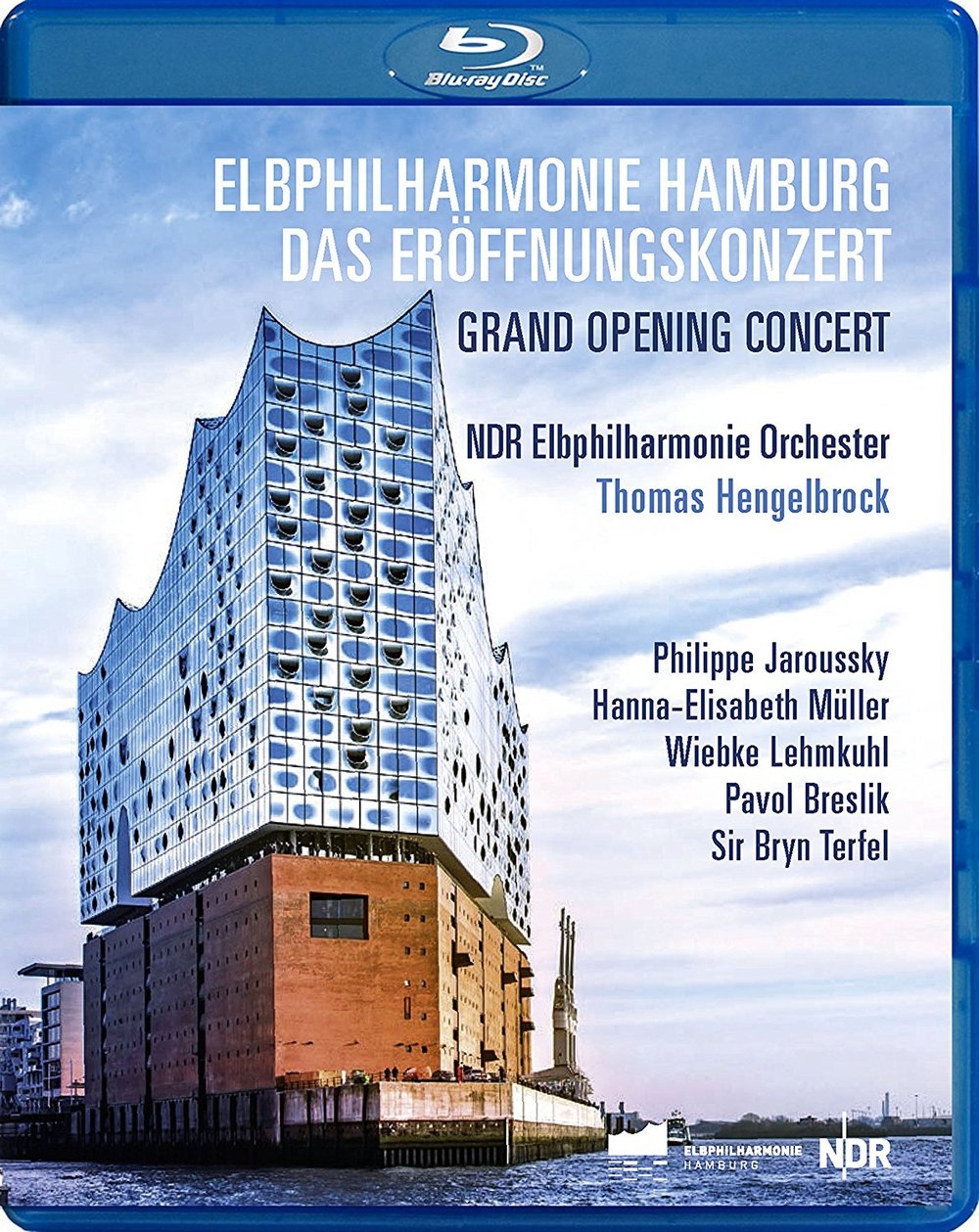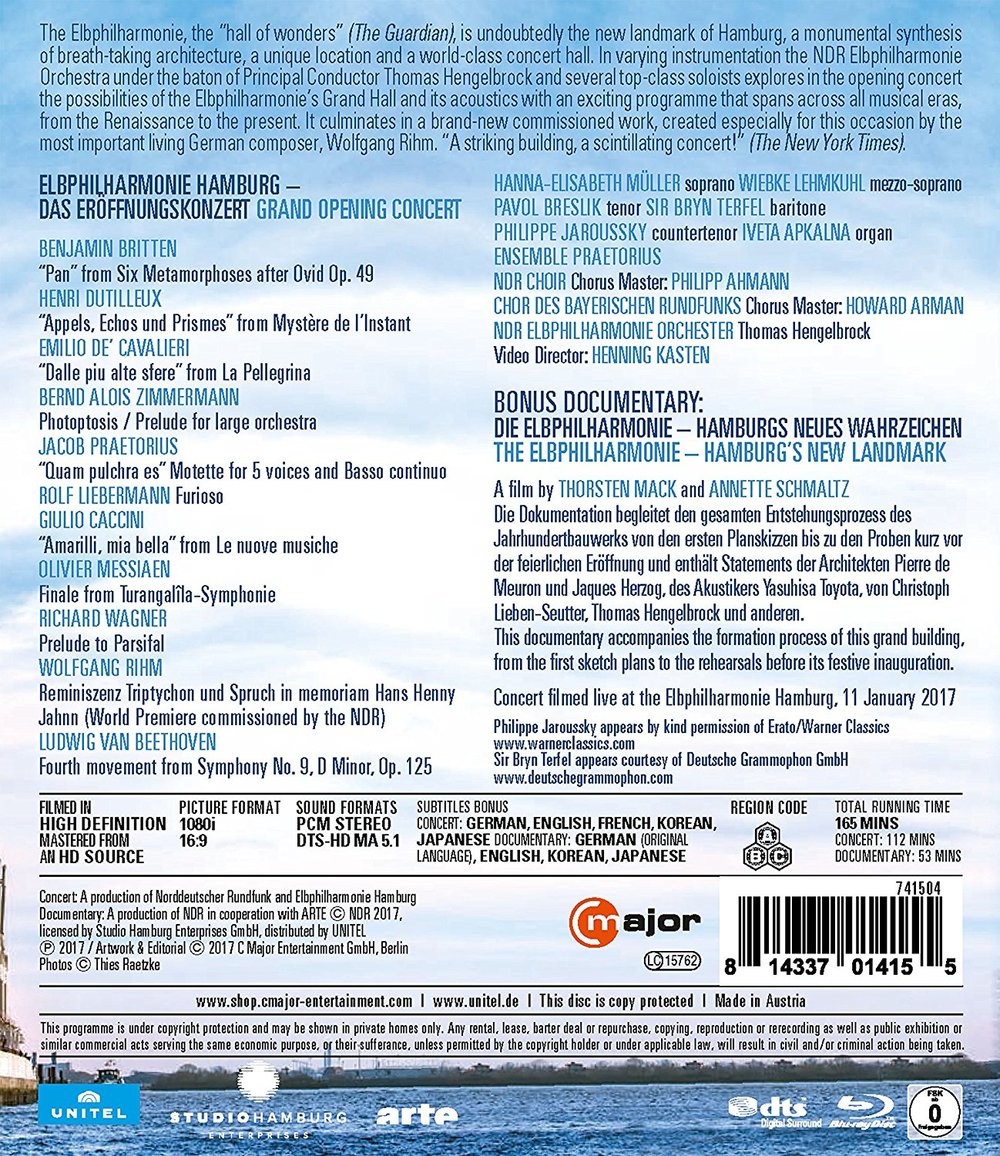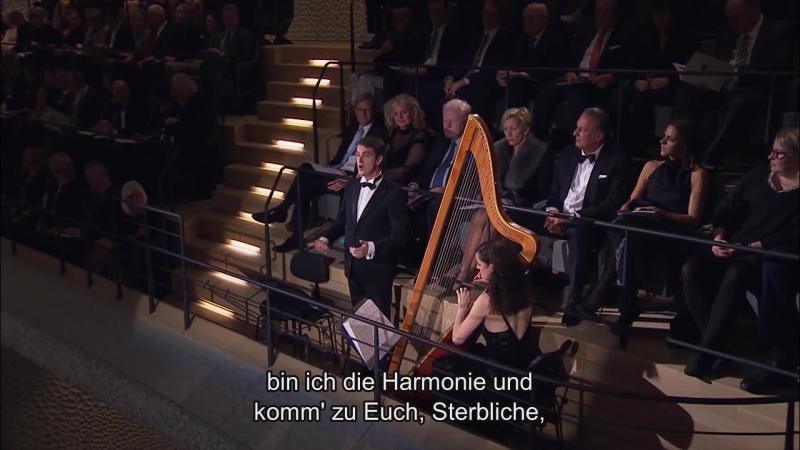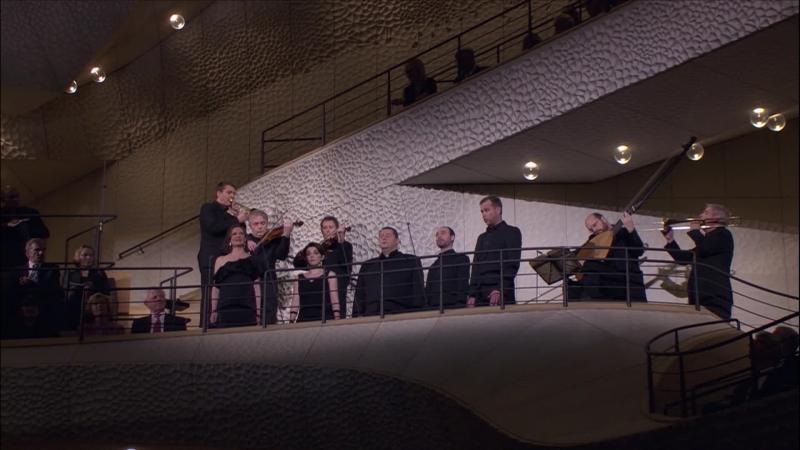

Elbphilharmonie Hamburg: Grand Opening Concert. This unique title celebrates the opening of the new über-world-class concert hall in Hamburg, Germany — the Elbphilharmonie Hamburg — with a challenging musical evening and a documentary about the amazing building. In early 2017, Thomas Hengelbrock conducts the NDR Elbphilharmonie Orchester, the Ensemble Praetorius, the NDR Choir (chorus master Philipp Ahmann), and the Chor des Bayerischen Rundfunks (chorus master Howard Arman). The Ensemble Praetorius includes: sopranos Ágnes Kovács and Alice Borciani, tenors Mirko Ludwig and Jakob Pilgram, bass-baritone Thilo Dahlmann, and Michele Pasotti on theorbo. They are supported (from the NDR Elbphilharmonie Orchestra) by Roland Greutter and Stefan Pintev on violin as well as Stepan Geiger, Uwe Schrodi, and Uwe Leonbacher on trombone (playing early instruments).
Here is the program, most of which is new in Blu-ray. Mercifully, there apparently was not one spoken word at the concert. All the music, lasting about 112 minutes, was played straight thru with applause only at the intermission break and at the end:
Benjamin Britten: "Pan" from Six Metamorphoses after Ovid for solo oboe, Op. 49 (Kalev Kuljus oboe)
Henri Dutilleux: "Appels, Échos, et Prismes" from Mystère de l'Instant
Emilio De' Cavalieri: "Dalle più alte sfere" from La Pellegrina (Philippe Jaroussky countertenor and Margret Köll harp)
Bernd Alois Zimmermann: Photoptosis / Prélude for large orchestra (Iveta Apkalna organ)
Jacob Praetorius: "Quam pulchra es" / Motette for 5 voices and Basso continuo (Ensamble Praetorius)
Rolf Liebermann: Furioso (Ya-ou Xie piano)
Giulio Caccini: "Amarilli mia bella" from Le nuove muische (Philippe Jaroussky countertenor and Margret Köll harp)
Olivier Messiaen: Finale from Turangalîla-Symphonie (Ya-ou Xie piano and Thomas Bloch ondes martenot)
Intermission
Richard Wagner: Prelude to Parsifal
Wolfgang Rihm: Reminiszenz Triptychon und Spruch in memoriam Hans Henny Jahnn (Pavol Breslik tenor and Iveta Apkalna organ)
Ludwig von Beethoven: Fourth Movement form Symphony No. 9 in D minor (Hanna-Elisabeth Müller soprano, Wiebke Lehmkuhl alto, Pavol Breslik tenor, Sir Bryn Terfel bass)
Directed for TV by Henning Kasten. There is also a 53-minute documentary by Thorsten Mack and Annette Schmaltz about the architecture of the new hall. Released 2017, disc has 5.1 dts-HD Master Audio sound. Grade: A-
When I started HDVDarts.com in 2007, I expected we would have Blu-ray titles on architecture to enjoy. But this hasn't happened — to my knowledge, there has been not a single Blu-ray published on architecture as art. But now we have a 53-minute bonus extra, shot mostly in HD, included in this title about the development of the Elbphilharmonie structure. So I divide this review into two segments: (1) the building and (2) the opening concert.
The Building
The new Elbphilharmonie is probably the only multi-purpose skyscraper symphony hall on earth. The first picture below (from photographer Michael Zapf) is the prettiest single image I've seen of the project. The building is on an island in the busy Hamburg port area. In the background you see that the north side of the Elbe river (where the city center is located) is rife with new development. I think this image of the building actually shows the "rear" of the Elbphilharmonie. The white machines are cranes that were used when the base building was a warehouse; they were preserved as reminder of the origins of the project:
On the south bank, one still sees major industrial works supported by Germany's most important harbor:
Below is another view of the north bank of the Elbe showing part of the center city. This was taken during construction. The white cranes had been temporarily removed:
The next image below shows a drawing of the the building from what I think is it's front (seen from the north or land side). The base of the building is the shell of an obsolete brick warehouse (that was gutted to the exterior walls). There are meeting rooms and utility areas in the base building. Visitors ride the world's largest curved escalator from the edge of the waters to a large and permanently open public area used for viewing the town center and the harbor. On top of the old structure is the new "glass crown" of the building. The crown holds a great symphony hall (up to 2,500 seats), smaller spaces for chamber music and recitals, rehearsal rooms, the symphony offices, a hotel, and (at the building's highest area) condominium apartments. Although the top is seen as a crown, it's really a design inspired by waves on the water. Thus the building is a marriage of many opposites: old and new; land and the waters, coarseness and refinement; ancient crafts and modern technology; commercial and residential life; industrial grit and artistic polish. It's a public building with something for everyone and a seat of power for wealthy patrons of the arts:
Next below is a shot of the Great Hall from its rear. This vineyard style auditorium is similar to but more refined than the Berlin Philharmonic hall. The huge circular sound reflector suspended from the ceiling spreads the sound of the orchestra to all points in the room.
The opening concert was the hottest ticket ever in Hamburg, so management came up with a way to appease those who couldn't get a seat — the damnedest spectacular light show you ever saw painted on and simultaneously shining out of a building — all coordinated with the concert being played inside the Great Hall and ending with the salutation "Hello World":
Now let's delve a bit deeper into the origins and details of the building. In 2001, the idea was floated that a symphony hall could be built within the walls of the old brick warehouse. But visionary city leaders soon dreamed of something more glamorous. By 2007, the cornerstone was laid for the grand conception of a glass crown to be erected over the earthen base of bricks:
Yasuhisa Toyota of Japan was hired to handle the design and acoustics of the Great Hall. But there could be no guaranties. The development of of symphony hall is always a gamble:
A 1/10 scale model of the main hall was made to study the acoustics. Here we see a head-shaped microphone inserted in amidst the well-attired concertgoers:
This hall is located right next to a river full of boats with whistles and fog-horns. Everything had to be completely sound-proof. For the Great Hall this was achieved by enclosing everything in a double shell shown below in white dots. The inner shell comes in contact with the outer shell only by resting on hundreds of unique steel spring capsules that absorb all sound energy from the outside world:
Many other building systems had to be invented. An unusual system of construction management also was created with the architects and the builders working in parallel chains of command with the Hamburg government at the apex of both. As project emergencies arose, the politicians dithered and dallied. In 8 years the cost of the project increased 10-fold from 77 to 789 million euros and the final tab was even higher. This is probably the most expensive symphony hall ever built:
An example of the many unusual building features is the inner skin of the Great Hall, which is made of a mixture of ground stone and paper. Next below we see how 10,000 unique panels were milled to build the inner skin:
The design calls for LED lighting to be inclosed in special "droplets" of glass. The only problem was that all the major glass fabricators stated that the droplets could not be manufacture as designed. After years of searching, the project manager found in the Czech Republic the tiny workshop of the Cerveny family, who invented new techniques to make the fixtures. Even so, only about half the globes blown were close enough to specs to be used:
Perhaps the greatest challenge of all was how to erect the steel beams to support the roof. When the safety numbers of the architects and the builder didn't agree, the project was halted for over a year. Some said the roof was unbuildable, but that seems now to have been too pessimistic:
Here is the back of Philippe Jaroussky auditioning the Great Hall---his comments are in the subtitle:
Did you ever see a window like this elsewhere?
Toyota observed it will take time for the orchestra to adjust to the Great Hall and only then can a judgment be made about the acoustics. But here is an early comment from conductor Hengelbrock:
The Opening Concert
This video shows the first public event ever in the new billion-dollar building. The bald man seen below is Olaf Scholz, the Mayor of Hamburg, with the most powerful woman in the world, the smiling Angela Merkel, seated next to her husband, Joachim Sauer:
The concert was designed to impress and reward the live audience, virtually all of whom were music lovers and politicians who had worked for years to get the new building finished. I think no cameras were placed where they would interfere with the enjoyment of the show by spectators. The video was a secondary effort mainly aimed at the TV market. So the videographer had to include tons of images of the building as well as the musicians. This next (ant-hill-style) shot with the orchestra and chorus shows that, even thought this is theater-in-the-round, the stage and hall have a front and back:
With the distances involved here, 2K cameras can't get very sharp pictures of the whole orchestra. (I wonder if anybody took 4K images of this?). Henning Kasten (who is known to usually shoot symphony orchestras DVD-style) was forced in this situation to mostly shoot close-ups of the orchestra musicians. So there are only about 8 large-scale, whole-orchestra views of the band like the image next below:
I usually don't like spy-in-the-sky images of a symphony because they are so different from what the audience can see. The next shot below is weak in 2K even if it does show well the huge percussion section. (In 4K, this view might be exciting.)
The concert was divided into two sessions with one intermission. The first session included 8 shorter pieces from Baroque to contemporary composers from many countries. The short selections were played without pauses between (no time to clap). The common aspect of these pieces was that each presents strange, wild, or other-worldly sounds pointing in spirit to the future. The first session represents musically the adventurous, risky glass crown of the building. The second session has 3 longer and heavier pieces from German composers and represents musically the solid brick base upon which the crown sits. (Let's ignore the fact that the only thing remaining of the old warehouse is the outer shell and the decorative cranes.)
As the lights first dimmed, the audience would have expected to hear the whole orchestra open the concert. But the first music ever heard by the public here was Pan, a short, abstract, and acidic oboe solo from Benjamin Britten played from the back of the hall!
This was followed by obscure orchestra music from Mystère de l'instant (Mystery of the Instant), for twenty-four strings, cymbals, and percussion, by Henri Dutilleux. Then suddenly the music shifted to different exotic sounds from counter-tenor Philippe Jaroussky with Margret Köll on harp. Located midst the audience, they played "Dalle piu alte sfere"("From the Highest Spheres"), part of La Pellengrina (The Pilgrim Woman) written by Cavalieri in 1589. Below we see Jaroussky singing, "I am harmony, and I come to you, mortals, (from the highest spheres):
The early-music Cavalieri piece is immediately followed by an all-out assault on the eardrums by the entire orchestra and huge organ in 12 minutes of total musical chaos called the Zimmermann Prélude from Photoptosis. And so on it goes between soft and loud, old and new until ending with the Finale from Messiaen's Turangalîla-Sinfornie. (I still remember decades ago listening to my new LP of Turangalîla-Sinfonie. I thought then it would be forever the most avant-guard music possible. But today it no longer sounds all that wild.)
This review is getting too long so I'll show just one more screenshot of musicians from the first session. Next below is the Ensemble Praetorius, augmented with violins and trombones from the Elb orchestra, playing music from 1606 (the year Shakespeare wrote Macbeth), which somehow manages to sound forward-looking:
And next I include two architectural shots---one interior and one exterior. This interior view below is not trick photography:
The exterior view also features the light show. Note below how the projected designs match up perfectly with 11 windows. See the YouTube clip below for much more about the light show. The subtitles below come from the Ensemble Praetorius song about lovers having fun going out into the fields:
And, of course, there are numerous shots of Hengelbrock:
After the intermission, the second session opened with the Prelude to Wagner's Parsifal, a piece for orchestra only that would always be appropriate for any solemn or festive occasion.
This was followed by the world premiere of Wolfgang Rihm's Reminiszenz Triptychon und Spruch in memoriam Hans Henny Jahnn. (My translation: Three-Poem Reminiscence and Aphorism in Memory of Hans Henny Jahnn.) Jahnn (1894-1959) was a Hamburg playwright, novelist, and organ builder who appears to be a local symbol (like the new Elbphilharmonie) of free-thinking audacity. Jahnn is buried in Hamburg in an unusual tyiptych-style family burial plot. On one side of Jahnn lies the grave of Ellinor, his wife. On the other side lies the grave of Gottlieb, his husband (I think). Don't try to figure it out---it's gets even more complicated than what I've already revealed.)
Below we see tenor Pavol Breslik singing from the text of the poem Widmung (Dedication). Jahnn is praised for his fearlessness in living beyond the boundaries of bourgeois mediocrity. My very rough translation of the subtitle would be "But you were called to heave up (things) from fiery depths of the earth."
Rihm's piece is not likely, I fear, to be long remembered or travel far from Hamburg. But the program closes with a sure-fire crowd pleaser, the last movement of Beethoven's Symphony No. 9. Next below is Sir Bryn Terfel voicing Shiller's prediction that "All men will become brothers."
And finally, we see the chorus singing the "Ode to Joy."
Now for a grade on this special title with the ‽ designation. This show was produced under a lot of time pressure. By ordinary standards the lighting is too dim, which results in weak video resolution. The video content is infected with DVDitis. The sound recording, while adequate, is not particularly impressive. Of course it would be wrong to apply our usual criticism for symphony recordings to this recording, which is really about a building and an event, not a concert. Still, I did "run the numbers" on the 1st session of music using a Wonk Worksheet. By awarding each architectural clip the designation of "other high value", I came up with a pretty good results on the pace, supershots, and conductor tests that we usually apply. So I will not deduct anything for weak video content. Because of weakness in PQ and SQ, I wind up with an A- grade for this disc as a record of an impressive event. I'll give the documentary an A- also. This results in an overall A- for this interesting title about about an amazing new concert hall.
For your convenience, I've linked to the text in German of the 4 poems that make up the libretto for Reminiszenz Triptychon und Spruch in memoriam Hans Henny Jahnn.
Finally, There's a ton of stuff about all this on YouTube. Here's just a taste:
OR
































